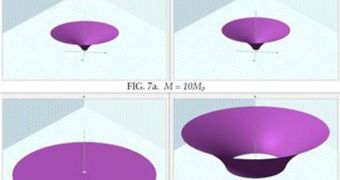The late UC Santa Cruz scientist Donald Coyne and Almaden Research Center expert D. C. Cheng proposed some time ago the hypothesis that all particles in existence were nothing more than mini-black holes. While disregarded at the time, the idea has gained some support in the academic community over the past years, with some experts saying that gravity, which at the astronomical scale has a considerable influence on everything from planets and solar systems to galaxies, but whose effects can be safely ignored on a small scale, regains its strength at the Planck scale, the smallest there is.
In the vastness of the Universe, black holes, ranging from the smallest to the supermassive type, can be found at the core of every galaxy, and also in other obscured regions. They exert such a strong gravitational pull on objects around them, that nothing, not even light, can escape it. That is to say, photons traveling incredibly fast have their paths distorted when they enter the field of action of a black hole. But their effects on the Planck scale were inferred from string theory, which states that higher-dimensional spaces experience a much higher influence from gravity.
That is to say, in the four dimensions that we live in – length, height, depth and time – the effects of gravity can safely be ignored on a small scale, such as the atomic one, as its influence on the results of tests carried out at this magnification level is considered to be negligible. But, as far as the theory goes, in higher-dimensional space, the small scale may be more heavily influenced by this force. As a direct result, the two researchers proposed, tiny black holes could exist at all energy levels of the Planck scale, and on such a wide scale, that they argued that, “All particles may be varying forms of stabilized black holes.”
The two researchers also established that particle accelerators such as the Large Hadron Collider could evidence the existence of these mini-black holes in several types of particles in the end, at different energy levels. If that turned out to be the case, they added, then, undoubtedly, all other particle accelerators in the world had thus far been producing microscopic black holes. But Coyne and Cheng warned about people looking at machines such as the LHC as “black hole generators,” as it might be the case that we were all made of black holes, to some extent.

 14 DAY TRIAL //
14 DAY TRIAL //